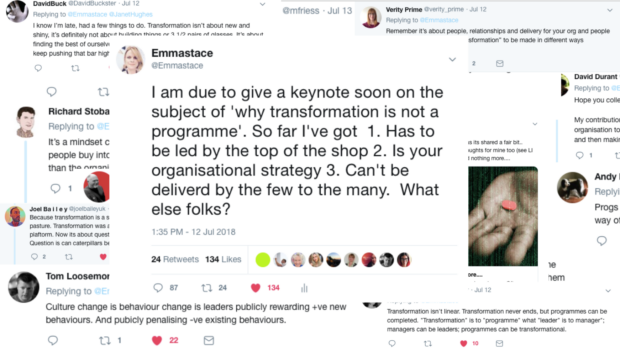
We talk a lot about transformation in government.
We have Transformation Programmes.
We transform Services.
We have Transformation Directors, Transformational Strategy and The 7 Lenses of Transformation.
Transformation sounds impressive, glamorous even, but what does it actually mean?
After six years of leading transformation in government, this is my attempt to explain what it is, what it’s not, and how to spot the difference.
It’s always good to start with a definition, and Cambridge Dictionary offers this one: ‘transformation: a complete change in the appearance or character of something… especially so that thing is improved’.
This gives us some clues, but it’s not nearly complete.
So with the help of my Twitter community, here’s 6 characteristics of what transformation is, and what it is not.
1. It’s a positive view of the future
The word transformation has a positive meaning.
Transformation implies things will change for the better. This may be why it’s used to badge traditional programmes that otherwise might be less well received by employees of an organisation.
Here’s an example. How often is the word transformation used to describe programmes which are about cutting costs and improving productivity? Good for the organisation no doubt, but maybe not so good for its employees.
So if the outcome of your transformation programme is efficiency, I’d recommend calling it what it is – an efficiency programme.
2. It’s irreversible
The Cambridge Dictionary definition refers to transformation as ‘... complete change’. This suggests permanent change.
You can change your jacket, your mind, your name, your boss or your job. ‘Complete change’ implies something less reversible and deeper. Once something is transformed there should be no going back to the way things once were.
It’s like renovating a house. From the outside things might still look the same but everything on the inside has changed such as the plumbing, electrics, lighting, interior walls, ceilings and floors.
If what you’re doing in the workplace is like gutting and improving the whole house, then you’re probably doing something transformational.
If what you’re doing is the equivalent of repainting the exterior of the house, or refurbishing a room or two inside, then consider ditching the word transformation and call it what it probably is – an improvement programme.
3. It’s inconvenient
Anyone who has lived through a house renovation will have been incredibly inconvenienced. Probably far more so than you imagined. The noise, the dust, the constant changes in plan. And once you get into the guts of the house there's plenty of things you didn’t see, or know when you first started.
Transformation is similarly inconvenient. It’s messy, uncomfortable, unknowable. You’re supposed to find lots of things that you had no idea were going to be problems.
So if things are simple, certain, knowable and straightforward – then you’re probably not doing something transformational. I’d suggest you call it whatever it is you’re doing – and leave transformation out of it.
4. It’s cultural
The focus of transformation should be on how we work. To use the house analogy again, you’re looking at rewiring, replumbing and reconfiguring how things work together, which in the context of your organisation – is how your people, their skills and behaviours – rub along.
This is cultural change and it’s difficult.
Delivering a programme does not change people’s behaviour. People change their own behaviour. The trick is to create the space in which people want to change.
And that’s where the importance of leadership comes in. Leadership at all levels of the organisation, not just at the top.
Here are three signs that tell you something transformational might be going on:
- the executive team are thinking about how their own behaviours can help or prevent change
- senior managers are helping to make the change happen
- front line staff are working in new ways to make things better for your users (or customers)
If you can't see these signs then you may be in the realm of hopeful thinking. Your ambition may be transformational but the rest of the organisation is not really with you.
5. It’s personal

Transformational efforts require us to think carefully about how we need to shift our own habits and behaviours. It requires feeling, reflection and personal growth and development.
Time and time again I've seen people approach transformational activity as an intellectual exercise. It's not.
Bill Sharpe, in 'Patterning of Hope', says, ‘We suffer from an attempt to know our way into a future instead of live our way’.
Transformation is about each of us living our way towards the future we are aiming to create.
We need to accept that our behaviours are our culture. And culture lives in the mindset we bring to work, and the way we behave at work.
One of the most simple but uncomfortable questions you can ask people who say they are supportive of the change is, ‘What are you going to do differently?’
For senior leaders this means understanding the behaviours that got you to the top, aren’t necessarily the same behaviours that will help lead the organisation into the future. Change needs to start with you.
Employees are sceptical. They’ve seen change programmes come and go, so they will look carefully at what people do, not what they say.
So if it's not personal, then I’d argue it’s not transformational, and you’re back into hopeful thinking.
6. Transformation is not a programme
This approach to organisational change cannot be delivered through a programme that has a start and end date.
Transformation needs to happen within both a context and culture set up to actively encourage exploration of ideas, experimentation and personal reflection.
The way we work, what we value, how we’re going to respond to the future as it emerges – none of these are in project initiation documents, programme dashboards or Gantt charts.
General McChrystal argues that transformational efforts need to be ‘consistently nurturing the structure, process and culture of your organisation with the aim of fostering an environment in which everyone is engaged in living their way to the future’.
His analogy is to lead like a gardener laying fertile ground – and then nurturing, tending, growing, and responding to your climate and context.
That’s transformational.
2 comments
Comment by Mark McLaren posted on
Great article Emma! I particularly like "create the space in which people want to change".
Comment by Lizzie Bruce posted on
Hi Emma, I missed your Twitter chat on this but you might like my article on The Myth of Digital Transformation! https://blog.prototypr.io/the-myth-of-digital-transformation-8f66a6d0eb07